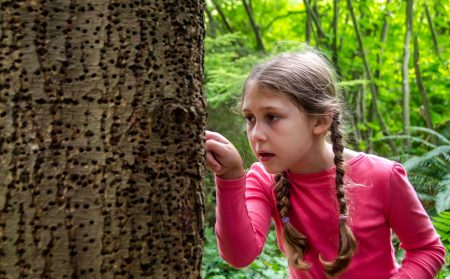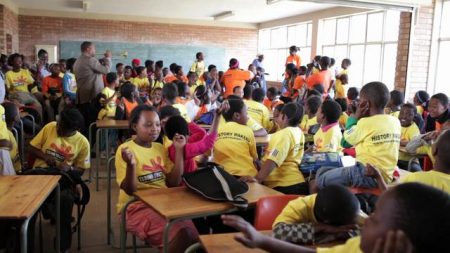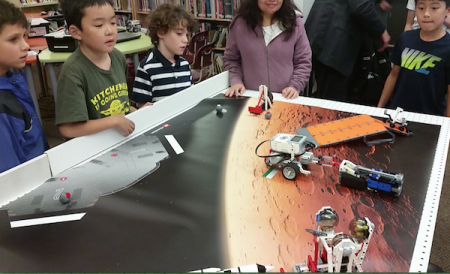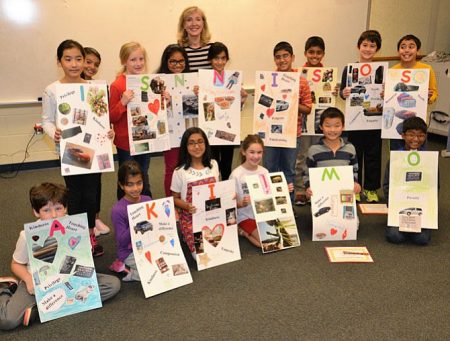November 23, 2016 – In yesterday’s post I introduced Peter Diamandis’ ideas on guiding principles for future education as well as his pet peeves about the way young people are taught today. In this posting, Part 2 in the series, Diamandis describes an elementary school curriculum for the 21st century. Diamandis is not alone in critiquing the way we teach young people. It would appear that many schools are “stuck in a groove” in the way they attempt to mass produce a common core of knowledge. Learning shouldn’t be done on an assembly line. It shouldn’t be prescribed by a public education model created to produce cookie cutter results. Particularly in the Age of the Internet where collective knowledge is accessible by touchscreen, many educators believe foundational learning must become more experiential and that the role of teachers should be to give students the tools of critical thinking to apply to problem solving. Rather than sages on the stage, teachers face relinquishing their traditional role of being the expert in the class, to being the facilitator and guide for knowledge seeking and proof. No job is more important for the future of humanity as is the role of teacher.
In a previous four part series which I entitled “Education and the 4th Industrial Revolution,” I described how educators need to be aware of disruptive innovation and make their students into continuous learners to adapt to the rapid change this century is undergoing. Diamandis’ take on how that curriculum should be designed follows.
Over the last 30 years, I’ve had the pleasure of starting two universities, International Space University (1987) and Singularity University (2007). My favorite part of co-founding both institutions was designing and implementing curriculum. Along those lines, the following is my first shot at a type of curriculum I’d love my own children to be learning.
[Diamandis is asking for feedback by providing a link to a survey where readers can give their opinions.]
For the purpose of illustration, I speak about “courses” or “modules,” but in reality these are just elements that would ultimately be woven together throughout the course of K-6 education.
Module 1: Storytelling/Communications
When I think about the skill that has served me best in life, it’s been my ability to present my ideas in the most compelling fashion possible, to get others on board, and support birth and growth in an innovative direction. In my adult life, as an entrepreneur and a CEO, it’s been my ability to communicate clearly and tell compelling stories that has allowed me to create the future. I don’t think this lesson can start too early in life. So imagine a module, year after year, where our kids learn the art and practice of formulating and pitching ideas. The best of oration and storytelling. Perhaps children in this class would watch TED presentations, or maybe they’d put together their own TEDs for kids. Ultimately, it’s about practice and getting comfortable with putting yourself and your ideas out there and overcoming any fears of public speaking.
Module 2: Passions
A modern school should help our children find and explore their passions. Passion is the greatest gift of self-discovery. It is a source of interest and excitement, and is unique to each child. The key to finding passion is exposure. Allowing kids to experience as many adventures, careers and passionate adults as possible. Historically, this was limited by the reality of geography and cost, implemented by having local moms and dads presenting in class about their careers. “Hi, I’m Alan, Billy’s dad, and I’m an accountant. Accountants are people who…” But in a world of YouTube and virtual reality, the ability for our children to explore 500 different possible careers or passions during their K-6 education becomes not only possible but compelling. I imagine a module where children share their newest passion each month, sharing videos (or VR experiences) and explaining what they love and what they’ve learned.
Module 3: Curiosity & Experimentation
Einstein famously said, “I have no special talent. I am only passionately curious.” Curiosity is innate in children, and many times lost later in life. Arguably, it can be said that curiosity is responsible for all major scientific and technological advances — the desire of an individual to know the truth. Coupled with curiosity is the process of experimentation and discovery. The process of asking questions, creating and testing a hypothesis, and repeated experimentation until the truth is found. As I’ve studied the most successful entrepreneurs and entrepreneurial companies, from Google and Amazon to Uber, their success is significantly due to their relentless use of experimentation to define their products and services.
Here I imagine a module which instills in children the importance of curiosity and gives them permission to say, “I don’t know, let’s find out.” Further, a monthly module that teaches children how to design and execute valid and meaningful experiments would open up the world of scientific methodology to them. Imagine children who learn the skill of asking a question, proposing a hypothesis, designing an experiment, gathering the data and then reaching a conclusion.

Module 4: Persistence/Grit
Doing anything big, bold and significant in life is hard work. You can’t just give up when the going gets rough. The mindset of persistence, of grit, is a learned behavior and I believe can be taught at an early age, especially when it’s tied to pursuing a child’s passion. I imagine a curriculum that each week studies the career of a great entrepreneur and highlights their story of persistence. It would highlight the individuals and companies that stuck with it, iterated and ultimately succeeded.
Further, I imagine a module that combines persistence and experimentation in game play such as that found in Dean Kamen’s FIRST LEGO League, where 4th graders (and up) research a real-world problem such as food safety, recycling, energy and so on, and are challenged to develop a solution. They must design, build and program a robot using LEGO MINDSTORMS®, then compete on a tabletop playing field.
Module 5: Technology Exposure
In a world of rapidly accelerating technology, understanding how technologies work, what they do and their potential for benefiting society is critical to a child’s future. Technology and coding (more on this below) are the new “lingua franca” of tomorrow.
In this module, I imagine teaching age appropriate kids through play and demonstration giving them an overview of exponential technologies such as computation, sensors, networks, artificial intelligence, digital manufacturing, genetic engineering, augmented/virtual reality and robotics, to name a few. This module is not about making a child an expert in any technology. It’s more about giving them the language of these new tools, and conceptually an overview of how they might use such technology in the future. The goal, get them excited, give them demonstrations that make concepts stick, and then let their imaginations run free.
Module 6: Empathy
Empathy, defined as “the ability to understand and share the feelings of another,” has been recognized as one of the most critical skills for children today. And while there has been much written, and great practices for instilling this at home and in school, today’s new tools accelerate this. Virtual reality isn’t just about video games anymore. Artists, activists and journalists now see the technology’s potential to be an empathy engine, one that can shine spotlights on everything from the Ebola epidemic to what it’s like to live in Gaza. And Jeremy Bailenson has been at the vanguard of investigating VRs power for good.
For more than a decade, Bailenson’s lab at Stanford has been studying how VR can make us better people. Through the power of VR, volunteers at the lab have felt what it is like to be Superman (to see if it makes them more helpful), a cow (to reduce meat consumption) and even a coral (to learn about ocean acidification). Silly as it might seem, these sorts of VR scenarios could be more effective than the traditional public service ad that attempts to alter human behavior. After VR experiences about the forest and its preservation we can expect people to waste less paper. VR can teach people to save more money for retirement, can make them act more nicely to people around them. This is a technology that could have consequences in terms of how we train and teach not only cliquey teenagers but also high court judges.
Module 7: Ethics/Moral Dilemmas
Related to empathy, and equally important, is the goal of infusing kids with a moral compass. Recently I toured a special school created by Elon Musk (the Ad Astra school) for his five boys (age 8 to 13). One element that is persistent in that small school of 31 kids is the conversation about ethics and morals, a conversation manifested by debating real-world scenarios that our kids may one day face.
Here’s an example of the sort of game play/role play that I heard at Ad Astra. Imagine a small town on a lake, in which the majority of the town is employed by a single factory. But that factory has been polluting the lake and killing all the life. It is posed that there are choices: shutting down the factory means everyone loses their jobs; keeping the factory open means the lake dies. What do you do?
This is the kind of regular and routine conversation/game play that gives children the opportunity to address the real world in a critically important fashion.
Module 8: The 3R Basics (Reading, wRiting & aRithmetic)
There’s no question that young children entering kindergarten need the basics of reading, writing and math. The only question is what’s the best way for them to get it? We all grew up in the classic mode of a teacher at the chalkboard, books and homework at night. But I would argue that such teaching approaches are long outdated, now replaced with apps, game play and the concept of the flipped classroom.
The flipped classroom, pioneered by high school teachers Jonathan Bergman and Aaron Sams in 2007, reverses the sequence of events from that of the traditional classroom. Students view materials, usually in the form of video lectures, as pre-class homework. During class time activities such as interactive discussions or collaborative work are done under the guidance of a teacher.
The benefits are clear:
- Students consume lectures at their own pace, viewing the video again and again until they get the concept, or fast-forwarding if the information is obvious.
- The teacher is present while students apply new knowledge. Doing the homework in class time gives teachers insights into which concepts, if any, are causing the students to struggle. This helps the teachers to adjust the in-classroom work accordingly.
- Flipped classroom produce tangible results: 71% of teachers noticed improved grades, and 80% reported improved student attitudes.
Module 9: Creative Expression & Improvisation
Every single one of us is creative. It’s human nature to be creative. The thing is that we each might have different ways of expressing our creativity.
We must encourage kids to discover and to develop their creative outlets early. In this module, imagine showing kids the many different ways creativity is expressed — from art to engineering to music to math — and then guiding them as they choose the area (or areas) they are most interested in. Critically, teachers (or parents) can then develop unique lessons for each child based on their interests using open education resources like YouTube and the Khan Academy. If my child is interested in painting and robots, a teacher or AI could scour the Web and put together a custom lesson set from videos/articles where the best painters and roboticists in the world share their ideas and skills.
Adapting to change is critical for success, especially in our constantly changing world today. Improvisation is a skill that can be learned, and we need to be teaching it early. In most collegiate “improv” classes, the core of great improvisation is the “Yes, and…” mindset. When acting out a scene, one actor might introduce a new character or idea, completely changing the context of the scene. It’s critical that other actors in the scene say “Yes, and…” accepting the new reality, then adding something of their own. Imagine playing similar role playing games in elementary schools, where a teacher gives the students a scene/context and constantly changes variables, forcing them to adapt and play.

Module 10: Coding
Computer science opens more doors for students than any other discipline in today’s world. Learning even the basics will help students in virtually any career, from architecture to zoology. Coding is an important tool for computer science, in the way that arithmetic is a tool for doing mathematics, and words are a tool for English. Coding creates software, but computer science is a broad field encompassing deep concepts that go well beyond coding. Every 21st century student should have a chance to learn about algorithms, how to make an app or how the Internet works. Computational thinking allows preschoolers to grasp concepts like algorithms, recursion and heuristics — even if they don’t understand the terms, they’ll learn the basic concepts.
There are more than 500,000 open jobs in computing right now, representing the number one source for employment in the United States. These are jobs projected to grow at twice the rate of all others.
And coding is fun! Beyond its practical uses there’s the fact that creating a game or animation can be exciting and joyful for kids.
Module 11: Entrepreneurship & Sales
At its core, entrepreneurship is about identifying a problem (an opportunity), developing a vision on how to solve it, and working with a team to turn that vision into reality. I mentioned Elon’s school, Ad Astra: here, again. Entrepreneurship is a core discipline there. Students create and sell products and services to each other within the school community. Teachers can recreate this basic exercise with a group of kids in lots of fun ways to teach them basic lessons of entrepreneurship.
Related to entrepreneurship is sales. In my opinion, we need to be teaching sales to every child at an early age. Being able to “sell” an idea (again related to story telling) has been a critical skill in my career, and it is a competency that many people simply never learn. The lemonade stand has been a classic, though somewhat meager, lesson in salesmanship from past generations. I’d suggest we step up the game and take a more active approach in gamifying sales. Maybe the classroom can create a Kickstarter, Indiegogo or GoFundMe campaign. The experience of creating a product or service and successfully selling creates an indelible memory and equips students with world changing skills.
Module 12: Language
I just returned from a week in China meeting with parents whose focus on kids’ education is extraordinary. One of the areas I found fascinating is how some of the most advanced parents are teaching their kids new languages through games. On the tablet, the kids are allowed to play games, but only in French. A child’s desire to win fully engages them and drives their learning rapidly.
Beyond games, there’s virtual reality. We know that for young adults full immersion is what it takes to become fluent in another language.A semester abroad in France or Italy and you’ve got a great handle on the language and culture. But what about for an 8-year-old? Imagine a VR module where for an hour each day, the child spends his or her time walking around Italy, hanging out with AI-driven game characters who teach and engage, sharing culture and language in the most personalized and compelling fashion possible.
Teaching young people how to sell. What an interesting concept and one with which I wholly concur. It is learning salesmanship that has given me many of the skills that made me successful as an editor, software and hardware developer, writer and presenter.
As for language, try Duolingo, a great way to play and learn from a free web site.
In Part 3 of Diamandis’ thoughts on 21st century education we’ll look at tools and mindsets. Stay tuned.










